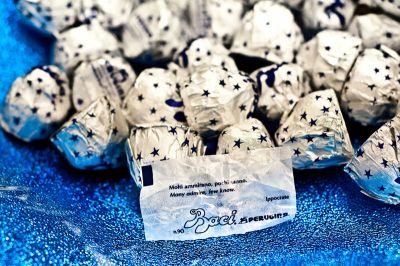l Baci Perugina sono considerati un po’ il simbolo di San Valentino. La data convenzionale della nascita di questa dolce creazione è il 1922 e l’occasione venne offerta da un tentativo di “riciclo creativo”. Allo scopo di ridurre i costi di produzione de La Perugina, una piccola azienda dolciaria con appena quindici dipendenti, Luisa Spagnoli, uno dei fondatori, sperimentò un impasto con la granella di nocciole che avanzava regolarmente dalle varie lavorazioni. Ci mise sopra una nocciola intera e lo ricoprì di cioccolato. Si deve a Giovanni Buitoni, un altro dei fondatori, l’idea di battezzarlo Bacio Perugina. Era il 1924 quando alla ricetta e al nome perfetto si unì un packaging che lo era altrettanto. L’iniziale confezione personalizzata (a cui solo nel ’40 vennero aggiunte le stelle per arricchire l’incarto con un simbolo di desiderio, speranza e fantasia) era ispirata al dipinto di Hayez “Il Bacio”, mentre la carta color argento con scritte blu nascondeva un bigliettino romantico all’interno di ciascun cioccolatino. Nel 1939 il successo superò i confini italiani arrivando in America, dove sulla Fifth Avenue a New York venne inaugurato un negozio Perugina.
It is one of the most recognized Italian kisses worldwide, filled with a blend of chocolate and chopped, roasted hazelnuts. Wrapped in tin foil and printed with shining little stars, each praline carries a special message of love and friendship. It comes packed in a dark blue box featuring a man and a woman tightly enveloped in each other’s arms. It’s the Bacio Perugina! The Italian Bacio has been around for 97 years.
It was born in 1922, thanks to the creativity of Luisa Spagnoli, an Italian entrepreneur also known in the world of fashion for her exquisite line of women’s clothing. While working at a small family business which later became the Perugina company, Spagnoli had the brilliant idea of blending chocolate with pieces of leftover hazelnuts, topping the mixture with a whole hazelnut and, finally, glazing it with melted dark chocolate. The result was an irregular-shaped ball whose contour resembled that of a closed hand. For this reason, the Bacio was formerly named cazzotto (punch). However, Giovanni Buitoni, one of the company’s business partners and supposedly Luisa’s lover, was not a fan of selling a product with such a strange name that inspired no charm. So, in 1924, it was baptized with the delightful nickname we call it by today, Bacio, meaning “kiss.”
Through the creative touch of the Italian graphic designer Federico Seneca, it acquired a whole new look becoming more appealing and extravagant. For the first time, it was dressed in its characteristic silver shell, adorned with the blue wording, customized with the love note, and enriched with the image of the kissing couple in reference to the work of art “Il Bacio” created in 1859 by the Italian artist Francesco Hayez. The Bacio is said to be the accomplice of a presumed love affair. According to legend, the idea behind the translucent love message originated from Luisa Spagnoli and Giovanni Buitoni’s clandestine involvement. Rumors had it that the two, a married mother of three and a man 15 years younger, slipped romantic notes inside the chocolate candies to communicate with one another, keeping their intimate relationship a secret.
In 1939, the Bacio made its debut across the ocean arriving in New York with the opening of the first Perugina store on the prestigious Fifth Avenue. Afterwards, when the Italian kiss was increasingly exported to other parts of the globe, it became multilingual. The little scroll inside was translated in several other languages.
The Umbria-born praline is like no other because it comes with words of love, friendship and wisdom borrowed from some of most internationally-known poets, writers and philosophers such as Dante Alighieri and William Shakespeare. So, while savoring a Bacio, you can enjoy reading the lines of Roman poet Virgil who believed that “l’Amore vince ogni cosa: e noi cediamo all’Amore” (“Love conquers all and we must yield to Love”) or Italian writer Grazia Deledda’s, “Le grandi cose si dicono in silenzio” (“The greatest things are said in silence”). The small Bacio Perugina has it all - looks, flavor, wisdom, romance, and history. Can you think of another chocolate kiss equal to the Italian Bacio? I certainly cannot!



